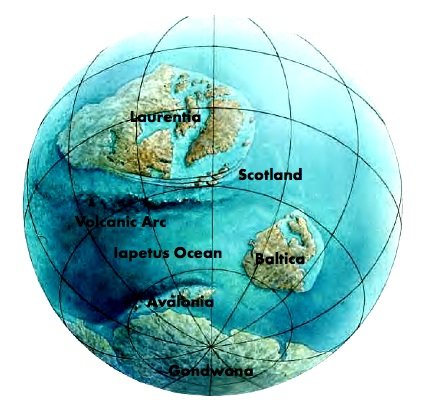 Post title...
Post title...
Post title...
Posted
|
Views: 1,195
formation. Finally, the Cuillin and Red Hills are adjacent, but very
geologically contrasting mountain ranges on the Isle of Skye. The geology
behind these four tourist destinations will be discussed below, but a brief
geological history of Scotland is necessary for their understanding.
Brief Geological History
After the Big Bang, the primordial Earth resembled nothing as it does
today. Continents were shifting, colliding and parting, moving from the Arctic
to the equator and back again. Over 500 million years ago, Scotland existed as
four disparate continental fragments and formed part of a large continent known
as Laurentia, which included parts of North America and Greenland. England and
Wales were part of a smaller continent known as Avalonia, separated from
Laurentia by the large lapetus Ocean.

Eventually this ocean closed, colliding Laurentia and Avalonia, creating
the mountains of the Highlands and uniting Scotland with England and Wales. At
the same time, the separate land fragments essentially slid together along
distinct geological fault lines, creating the current configuration of Scotland (below).

This mountain building event was known as the Caledonian orogeny. The newly united continent drifted across the planet, spending time in almost all Earth’s climatic zones including equatorial and desert, and eventually where it exists in present day. Beginning around 60 million years ago, the Atlantic Ocean formed from a thinning and diverging in the Earths crust, and Scotland drifted away from the rest of Laurentia. This stretching allowed molten rock to emerge at the surface that created a chain of volcanoes running along the west of Scotland. From this point until present day there were numerous periods of glaciation coupled with massive amounts of erosion to shape the landscape of Scotland we see today.
Loch Lomond and the TRossachs
In 1810, the Scottish writer Sir Walter Scott wrote a poem set in the
beautiful Trossachs area, bringing thousands of tourists to the area. Following
this, Loch Lomond gained international attention because of the traditional
Scottish song ‘The Bonnie Banks o’ Loch Lomond.’ Together, these two locations
form arguably the most beautiful scenery in Scotland, and was designated as a
national park in 2002.
"By Yon bonnie banks an' by yon bonnie braes
Whaur the sun shines bright on loch lomond
whaur me an' my true love wiLL ne'er meet again
on the bonnie, bonnie banks o' loch lomond"
Whaur the sun shines bright on loch lomond
whaur me an' my true love wiLL ne'er meet again
on the bonnie, bonnie banks o' loch lomond"
 Magazine Posts
Magazine Posts Table of Contents
Table of Contents